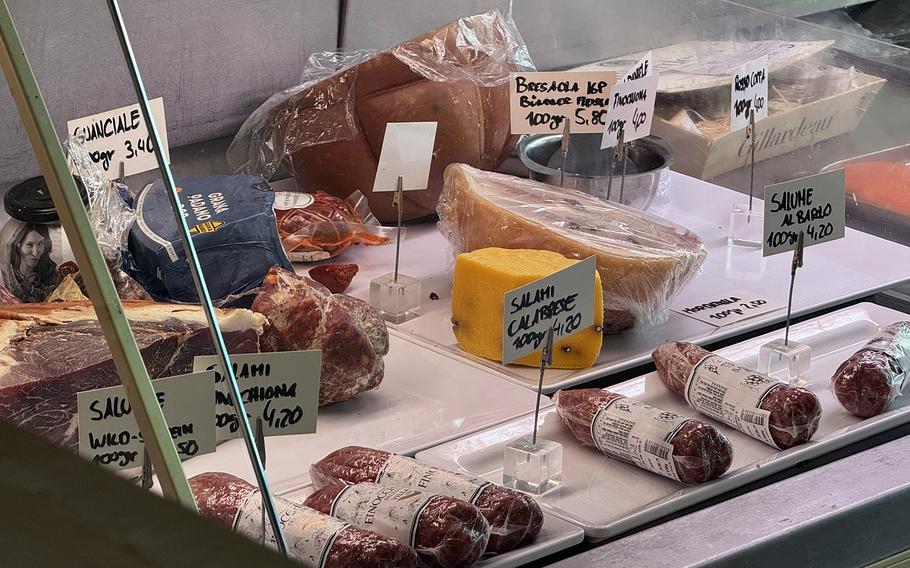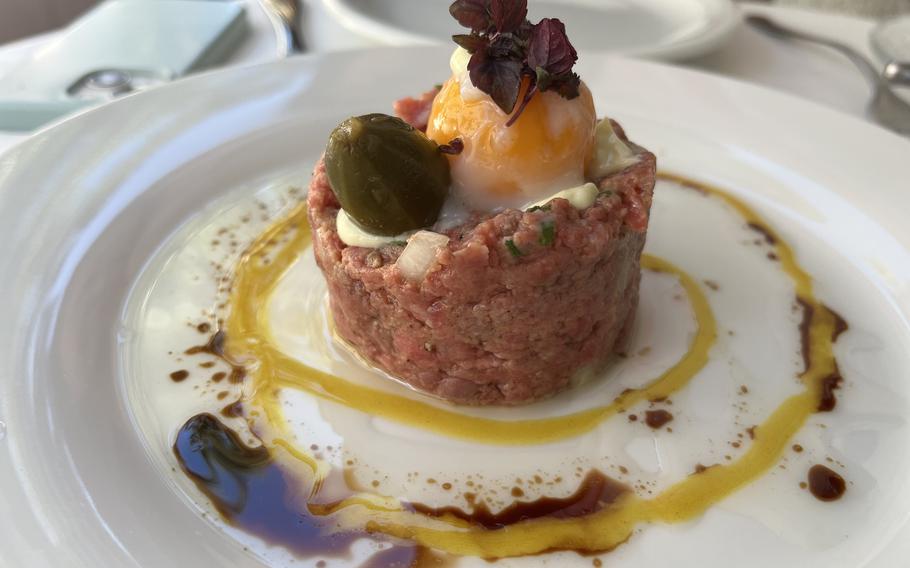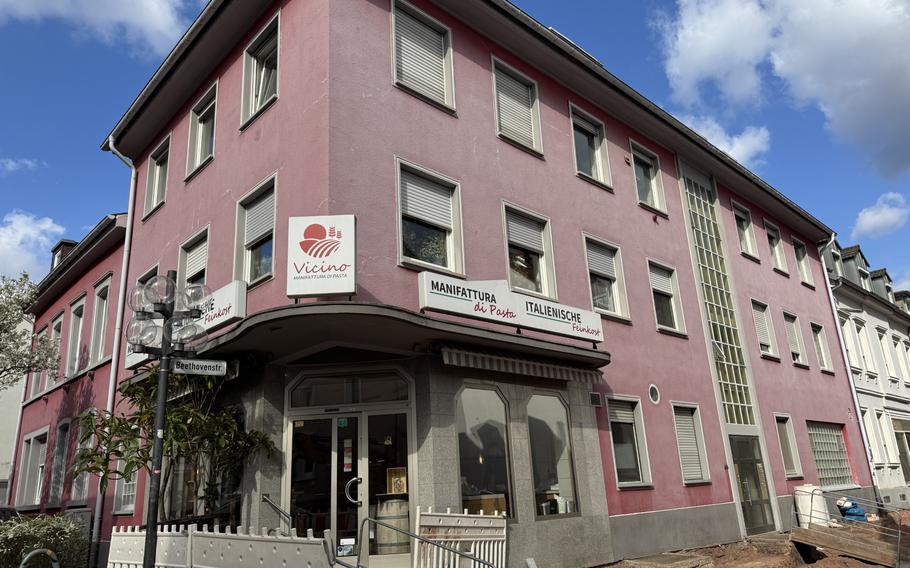
A tender steak filet with truffle, asparagus and a crisp potato side at Vicino in downtown Kaiserslautern. (Zade Vadnais/Stars and Stripes)
At first, I wasn’t even sure I was in the right place.
I’d wandered through city construction, ducked around scaffolding and stepped into what looked like a retro deli. No host stand, no signs — just a few tables and the hum of a kitchen.
The lunch and dinner experiences are different at Vicino, says the long-time Kaiserslautern resident and colleague who directed me here, calling it the best Italian food for miles — and it isn’t close, he said.
I’ll offer you two different points of view on Vicino. I’m the first-timer who doesn’t normally seek out anything upscale. I’ll also share what a colleague who has eaten his way through Italy and says things like “amuse-bouche” without irony had to say through five visits.
The front room of Vicino is tiny — the tables are tucked in near shelves of limoncello and wine. A butcher counter, a holdover from the building’s past, sells take-home meals and charcuterie.

The old butcher counter still does good business, now stocked with cured meats, cheeses and other take-home temptations at Vicino in Kaiserslautern. (Zade Vadnais/Stars and Stripes)
Around the corner is a larger dinner dining area, which combines modern accents with the industrial chic of the old butcher shop. But from my seat, Vicino felt more like a tucked-away neighborhood café than a full-service restaurant.
I sat down to a basket of bread with a dollop of whipped ricotta, served on a tiny stone dish. It was topped with a delicate parmesan crisp and a sprinkle of fresh chives — a small bite, but beautifully composed.
When that artfully plated dish landed in front of me, I began to wonder if I was out of my depth. But what I’d find throughout the meal were familiar dishes with unexpected yet accessible flavor, Instagram-worthy plating with a touch of theater.
I had come with the intention of trying the restaurant’s handmade pasta, but the creatively conceived menu convinced me to veer off course.
Here’s where I’ll let my colleague, we’ll call him Skip (not his real name), jump in:
“You should have tried the pasta,” he said. “There are a few places here that make good-enough pasta, but this was the first and only place where I had one bite and thought, ‘I would eat this in Rome.’”
The pasta varieties and accompaniments change often and may include wild boar sausage, scallops or even a less adventurous but well-executed meat sauce, he said.
I opted for a starter and one of the daily specials, offered together as a set.
But first, a gift from the kitchen was placed in front of me. A small, white disk sat in the center of a bowl, something between panna cotta and fresh cheese, topped with three delicate dots of homemade mayonnaise and crisped potato bits.
A server appeared with an iron teapot and poured in a red beet broth that circled the disk like watercolor. The broth was light and earthy at first, but as the cheese slowly melted, it turned creamy and lush.
It was lovely — but also soup. And I’d ordered another soup as my actual starter. But I didn’t regret it.
The next dish was served the same way: the core plated first and the broth poured tableside. A smooth puree surrounding a crisped piece of white fish topped with three more piped dots of sauce.
This soup was darker and deeper than the first, and the dots of sauce had the faintest touch of wasabi. Not enough to burn, but just enough for me to pause and consider what exactly I was tasting.
Each dish arrived with edible garnishes shaped like little leaves or twigs, and the service was smooth, quiet and almost invisible. My silverware was swapped out between courses without a word or even a noticeable gesture.
My entree was a small steak filet, cooked medium and topped with shaved truffles. It was garnished with a creamy white sauce and a brown jus, finished with three spears of asparagus and served alongside a potato mille-feuille — crisp on the outside, layered with cheese and more truffle on top.
Truffles might be lost on me, but a steak done exactly as you want it is easy to recognize.

The beef tartare at Vicino in Kaiserslautern, Germany. The offerings at the downtown Italian restaurant are sometimes adventurous and sometimes familiar, but always artfully dressed. (Erik Slavin/Stars and Stripes)
Skip says this matched up with his impressions of lunchtime, which in some ways he preferred over dinner.
“Fewer tables means better service,” he said. “And when the construction clears away, they’ll have tables outside.”
Skip added that the wine offerings by the glass are better than most restaurants and that the staff knows how to pair them to what you’re eating.
The downsides to Vicino? When it gets warm, you may really want to eat al fresco if too many flies from the street come through the open door.
Skip added that one of his dinners had friendly but very slow service. The Italian expectation of multiple courses and lots of conversation doesn’t always hold in Germany.
But other than that, he’s enjoyed everything he’s eaten there, from appetizer to dessert.
I’d have to agree. The food struck a balance between creativity and comfort. You don’t need a refined palate to enjoy it — just an open mind and a healthy appetite.

Fresh pasta and daily specials made are available for lunch at Vicino in Kaiserslautern.The dinner dining room is a few doors to the right of the corner entrance. (Zade Vadnais/Stars and Stripes)
Vicino
Address: Glockenstrasse 55, Kaiserslautern, Germany
Hours: Butcher counter and wine bar, Monday through Wednesday, 9 a.m.-6 p.m.; Thursday through Saturday, 9 a.m.-10 p.m. Lunch from noon-4 p.m. Monday through Friday and 11:30 a.m.-2 p.m. Saturday. Dinner served Thursday through Saturday, 6-9 p.m.; reservations strongly recommended. Closed Sundays.
Prices: Lunch entrees between 15-22 euros per person. Dinner is slightly more.
Information: Phone: +49 173 354 5981; Online: facebook.com/VicinoKL